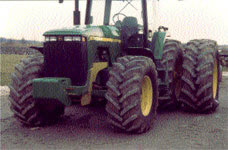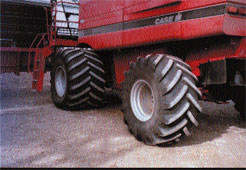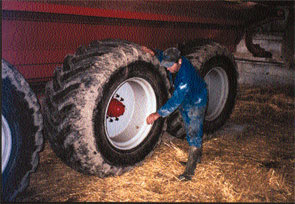
Feeling Deflated? Congratulations!
Reducing the risk of soil compaction causes some immediate pain in the wallet, but can corn producers afford not to take steps to protect their soil from over-compaction?
Ontario’s corn-growing season has two real problems. It starts too late and ends too early. The resultant rush to apply nutrients, get the crop planted or get it harvested, often requires the operation of large equipment in less than ideal conditions. Soil compaction from wheel traffic is perceived by most corn producers as an ongoing threat to productivity, but three substantial obstacles stand in the way of reducing the compaction risk:
1) the cost of moving to running gear which is less likely to compact soils
2) the lack of equipment options that can reduce compaction without significantly hampering the efficiency of the farm operation
3) the confusing effects of soil type, weather patterns and crop response that make the cost/benefit decision difficult.
The Cost
Soil compaction is caused by two primary forces: high inflation pressures and high axle loads. Inflation pressure is the dominant force in causing compaction in the plow layer, while high axle loads are the culprits if soil compaction is found below the depth that most growers would care to do tillage.
The German scientist Soehne was the first to distinguish between inflation pressure and axle load effects. Simply put, if you run a pickup truck with 35 PSI in the tires across a field, some air will be squeezed out of the soil. The relatively small tire size and low axle weight of the truck dictates that compaction will generally not radiate very deeply into the soil profile. Consider, however, a grain cart with the same 35-PSI inflation pressure, but with large tires and an axle load of 10 tonnes. The severity of compaction in the soil surface will not be much different than with the pickup truck (wider but not more intense) as this is controlled by the inflation pressure. The big difference is that the stress from the grain cart tire and potential compaction will extend much deeper into the soil profile.
On the inflation pressure issue, the most significant progress has been made on farm tractor tires. Fitting large radial tires on MFWD tractors has allowed for significantly reduced inflation pressure and thus lowered the risk of compaction, particularly when performing many spring field operations. The example used here is the John Deere 8310 used at the Elora Research Station-fitted with 600/65R28 R1W (front tires) and 710/70R38 R1W (rear tires), - see Figure 1. When set up on a tractor used for pulling towed implements, these tires can operate with 10 PSI in the front tires and 6 PSI in the rear duals. A dramatic reduction from the 18 PSI and 12 PSI required if you fitted the tractor with 16.9R30 and 18.4R46. On a new tractor order, Rob Klein from Elmira Farm Service approximates the additional cost for the larger tires is roughly $6,000.

Figure 1.
Significant opportunities exist to equip tractors with larger, lower inflation pressure tires.
High axle loads are the name of the game when it comes to fall harvest operations. Example number two comes from BlythBrae farms, where Steve Broad has fitted his CaseIH 2366 combine with large volume radial tires in order to reduce inflation pressures. This combine (see Figure 2) has a front axle weight approaching 15 tonnes when the grain tank is full. Installation of Michelin 1050/50 R 32 tires allows an operating inflation pressure of 15 PSI. Bruce Barnim of Al’s Tire, Burgessville, gives an approximate cost of $10,000 to upsize the rims and supply tires on a new combine (this cost would be in addition to trading in the new tires that come on the combine). Broad is pleased with the performance of the tires and excessive wear, sometimes associated with lower inflation pressures, has not been a problem.

Figure 2.
Front axle loads on combines can reach 10-18 tonnes when
the grain tank is full.
Like harvest operations, the spreading of liquid manure can be a time-sensitive operation, and wet soils either in the spring or fall may lead to compaction concerns. Observations indicate that the industry is not moving very rapidly to provide low inflation pressure options for grain carts and manure tankers, even though axle weights continue to climb. Example number three comes from Gerrit Dekker of Springfield, who is pushing the envelope in trying to reduce the risk of compaction from his liquid manure spreading operation. His tanker is a Bodco 5500-gallon (Imperial) spreader with 3 axles (see Figure 3). Axle weights across the fully loaded machine are approximately 9 tonnes (front), 12 tonnes (middle) and 14 tonnes (rear). Dekker added an additional $3,000 to the cost of the machine to equip it with Alliance 700/50-30.5 tires and is getting away with inflation pressures in the 19-22 PSI range. This is in contrast to the 35 PSI often recommended on 23.1-26 or 28–26 tires.

Figure 3.
Gerrit Dekker of Springfield looks to lower the risk of soil compaction on his manure tanker.
The Gain
This story could be pretty simple if we experienced consistent yield advantages from running lower axle weights or low inflation tires. The reality is that crop response to wheel traffic imposition is a complicated picture. The following factors generally contribute to increased crop loss from wheel traffic:
1) high soil moisture content at time of traffic
2) high clay content of the soil
3) less time for improvement following wheel loading due to wet/dry, freeze/thaw cycles
4) tillage intensity following traffic.
All of these factors also interact with the climatic conditions that prevail during the crop production year. In the late 1980s, we established a project at Elora to evaluate a widespan tractor with a 20’ wheel base that would allow all field operations to be performed on the plots with virtually no wheel traffic (see Figure 4). The counterpart to this plot was tracking a John Deere 7720 combine (front axle weight of 12 tonne) over the plot on a wheel track-to-wheel track basis each fall and then completing other field operations with normal equipment and traffic patterns. We then evaluated soil conditions and corn yields over several years. Soil compaction extended down to 35 cm (14 inches) on the plots where the combine had run, but corn yields were generally not reduced compared to the traffic-free plots. International research has also shown a wide range of crop responses to soil compaction. So let’s boil it down to a few conclusions.

Figure 4.
Widespan tractor used in compaction experiments at Elora to eliminate traffic from plots.
1) If your farming operation has single axles carrying more than 10 tonnes, there are very real possibilities that you are causing some level of compaction below 8 inches (20 cm). You probably are not going to shift to lighter equipment, so running bigger tires and lower inflation pressures is one key option. On fine-textured or poorly drained soils that are often wet during field operations, the payback on tire investment is very likely. The payback period will be variable, however, depending on weather conditions.
2) If your operation is focusing on no tillage or shallow tillage (less than 3 inches or 7.5 cm), high inflation pressures, which compact the surface soils, are a threat to yields and you should be more motivated to move towards lower inflation pressures.
3) However, the risk of compacting the soil deep (below plow depth) when running high axle loads cannot be completely eliminated with lower inflation pressures.
4) Note also that moving to lower inflation pressures is not as simple as letting some air out of your tires. You will need to confer with tire and equipment experts to make the right decision for the tires and loads you are working with.